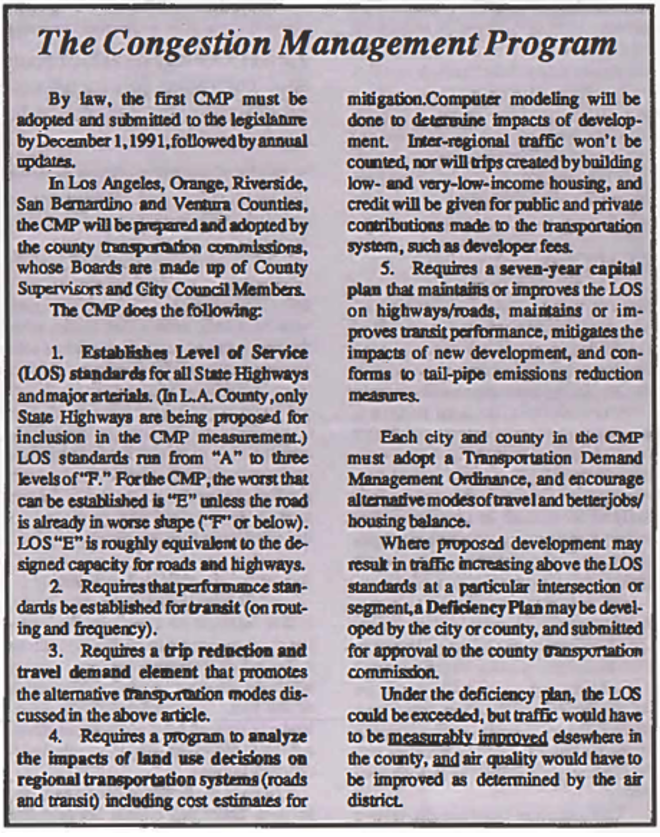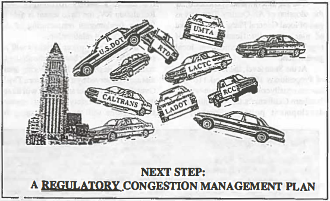Land use and transportation are interconnected yet the recent past was filled with legislation that would say the otherwise. Jim Sims, President of Commuter Transportation Services, writes on Congestion Management Program (CMP) that aims to reduce traffic congestion. The CMP is a recent program that ties together land use and transportation.
Developers have always understood the strong link between transportation and land use. In the last decade, the public and its elected officials have become increasingly aware of it, too.
When the bipartisan agreement to raise the state gas lax was hammered out last year, the negotiators wrestled with how to make sure new transportation funds would not stimulate development which would worsen traffic.
What evolved is the Congestion Management Program, or CMP. This program formally ties local government land use decision-making to regional transportation planning.
To developers it means a new layer will be added to the project approval process by 1992.
Local governments will have to measure the impact of development on roads and transit through a countywide computer model. Projects which overload the system beyond mobility standards to beset December of 1991 will most likely be required by local governments to mitigate traffic, either by fees, construction of park-and-ride lots, or direct provision of services such as transit.
Projects which generate more traffic than CMP standards can trigger a “Deficiency Plan,” where a city could find a way to measurably improve traffic somewhere else in the county.
While the County Transportation Commissions in Los Angeles, Orange, Riverside, San Bernardino and Ventura counties will prepare the CMP for each county by December 1, 1991, specific details will be determined by local elected officials in every urban city and county in the state through adoption of local ordinances.
There is good reason to expect that cities will take this mandate to adopt trip reduction ordinances seriously. If a city doesn’t adopt one, it doesn’t get any of the funds from the Prop 111 gas tax increase.
Demand Management
The most cost effective ways to ease traffic overload caused by development are through ridesharing (including transit), vanpooling, flexible work hours, telecommuting, and park-and-ride programs. These fall under the umbrella of Transportation Demand Management, or “TDM” strategies, and will be the backbone of local trip reduction ordinances.
The CMP provides a framework for developers to more easily get the support they need from the public and private sectors, but it will come at a price.
For example, if transit service to a new development is needed as part of the TDM strategy, developers will have to come up with a way to subsidize it. Or if traffic from a project can’t be mitigated locally, a “Deficiency Plan” might require contributions to projects like park-and-ride transit centers in other parts of the county.
Making the CMP Work for You
Developers who design buildings to facilitate TDM will find more political and public support for their projects, and fare better in the CMP process. They’ll also enjoy a competitive advantage in leasing space to the companies that must comply with air district regulations such as “Regulation XV,” the SCAQMD trip reduction rule.
Following are ways these features can be incorporated into building design:
(1) Parking: Provide fewer parking spaces relative to an office’s floor area than is customary today. Reserve “priority” spaces for vanpool and carpool vehicles and bicycles (with showers and clothing lockers). Design drop-off/pick-up areas for car and vanpool assembly and transit. Provide adequate height clearance for vans and minibuses. Build or contribute to funds for remote park-and-ride facilities.
(2) On-site amenities for office and park-and-ride complexes: Cut down on the need for tenants to have cars for errands by including on-site services and amenities such as daycare centers, restaurants/fast food outlets, small markets/drugstores and dry cleaners. Allocate space for a commuter store and/or building transportation coordinator, or provide for membership in a Transportation Management Association within your lease.
(3) Security and features to promote flexible work hours: Since many employees participating in alternative work arrangements will work during off-peak hours, plan space for round-the-clock security guards, or provide card-operated security systems. Install highly customized heating, air-conditioning and lighting systems, because tenants will be using only a fraction of the total floor area during off-peak hours.
(4) Telecommuting: Provide the capability for convenient telephone and computer linkage to home or remote neighborhood telecommuting centers. Include telecommunications capacity for office tenants to perform tasks that presently require them to leave the office.
- Log in to post comments





